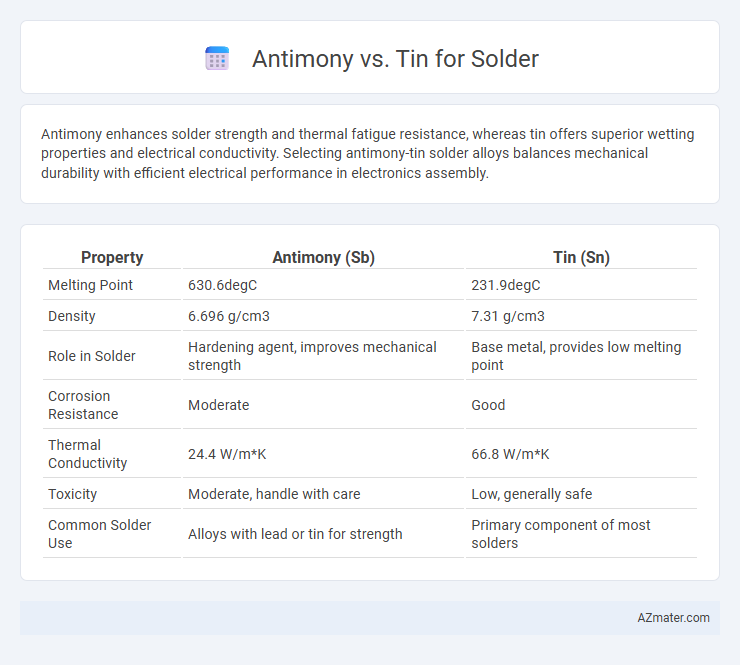Antimony enhances solder strength and thermal fatigue resistance, whereas tin offers superior wetting properties and electrical conductivity. Selecting antimony-tin solder alloys balances mechanical durability with efficient electrical performance in electronics assembly.
Table of Comparison
| Property | Antimony (Sb) | Tin (Sn) |
|---|---|---|
| Melting Point | 630.6degC | 231.9degC |
| Density | 6.696 g/cm3 | 7.31 g/cm3 |
| Role in Solder | Hardening agent, improves mechanical strength | Base metal, provides low melting point |
| Corrosion Resistance | Moderate | Good |
| Thermal Conductivity | 24.4 W/m*K | 66.8 W/m*K |
| Toxicity | Moderate, handle with care | Low, generally safe |
| Common Solder Use | Alloys with lead or tin for strength | Primary component of most solders |
Introduction: Understanding Solder Alloys
Antimony and tin are key elements in solder alloys, each offering distinct properties that affect melting temperature, mechanical strength, and corrosion resistance. Tin-based solders are preferred for their low melting points and excellent wettability, crucial for delicate electronic assemblies. Incorporating antimony enhances hardness and thermal stability, making it valuable for applications requiring durable and heat-resistant joints.
Chemical Properties of Antimony and Tin
Antimony exhibits a high melting point of 630.6degC and is chemically stable, providing hardness and brittleness when alloyed in solder. Tin, with a melting point of 231.9degC and excellent corrosion resistance, acts as a ductile base metal that enhances solder's flexibility and wetting properties. The combination of antimony's rigidity and tin's malleability optimizes solder performance in electronic and plumbing applications.
Melting Points: Antimony vs Tin
Antimony has a melting point of approximately 630degC (1166degF), considerably higher than tin's melting point of about 232degC (450degF), making antimony suitable for high-temperature solder applications. Tin, with its lower melting point, is ideal for electronics soldering where sensitive components require gentle heat. The substantial difference in melting points influences their roles in alloy compositions, balancing melting temperature and mechanical properties in solder formulations.
Mechanical Strength and Durability
Antimony enhances mechanical strength and durability in solder alloys by increasing hardness and resistance to deformation, making it ideal for high-stress electronic joints. Tin, while providing excellent solderability and corrosion resistance, offers lower mechanical strength and can be prone to creep under prolonged mechanical load. Combining antimony with tin improves solder joint longevity by balancing toughness with ductility, optimizing performance in demanding electrical applications.
Electrical Conductivity Comparison
Antimony and tin exhibit distinct electrical conductivity profiles that influence their performance in solder applications. Tin, with a conductivity of approximately 9.17 million Siemens per meter (MS/m), surpasses antimony, which measures around 0.99 MS/m, making tin significantly more effective for minimizing electrical resistance in solder joints. The higher conductivity of tin ensures better signal integrity and reduced energy loss in electronic connections compared to antimony.
Corrosion Resistance of Antimony and Tin Solder
Antimony in solder alloys enhances corrosion resistance by forming stable intermetallic compounds that protect joints from oxidation and degradation in harsh environments. Tin solder, while widely used for its low melting point and excellent wetting properties, is more susceptible to corrosion, especially in the presence of moisture and acidic conditions. The addition of antimony improves the durability and longevity of soldered connections by reducing tin's vulnerability to electrochemical corrosion processes.
Applications in Electronics and Industry
Antimony enhances solder alloys by improving hardness and mechanical strength, making it ideal for high-reliability electronic components and industrial machinery requiring durability under thermal cycling. Tin serves as the primary base metal in solder due to its excellent wettability and low melting point, essential for efficient electrical connections in circuit boards and consumer electronics. Combining antimony with tin optimizes solder performance by balancing conductivity, joint integrity, and resistance to thermal fatigue in demanding electronic and industrial applications.
Cost Analysis: Antimony vs Tin Solder
Antimony solder offers a lower cost alternative compared to tin solder, primarily due to the abundance and lower processing expenses of antimony. Tin solder prices fluctuate more significantly influenced by global demand and supply constraints in the electronics industry. Evaluating total cost of ownership, antimony provides economic benefits in high-volume manufacturing despite tin's superior thermal and electrical properties.
Environmental and Health Considerations
Antimony in solder poses higher environmental and health risks due to its toxicity and potential to bioaccumulate, leading to concerns during manufacturing and disposal processes. Tin, especially lead-free varieties, offers a safer alternative with lower toxicity and better compliance with regulations like RoHS, reducing harmful exposure to workers and ecosystems. Choosing tin-based solder supports sustainability goals by minimizing hazardous waste and promoting safer recycling practices.
Choosing the Right Solder: Antimony or Tin?
Antimony in solder enhances hardness and mechanical strength, making it ideal for high-stress electrical connections, while tin offers superior wetting properties and corrosion resistance favored in electronics with fine circuitry. Selecting between antimony and tin solder depends on the application's thermal demands and durability requirements; antimony alloys excel in environments exposed to mechanical vibration, whereas tin-rich solders provide better conductivity and longevity in delicate assemblies. Understanding the thermal conductivity, melting point, and alloy compatibility of antimony versus tin is crucial for optimizing joint reliability in specific manufacturing processes.

Infographic: Antimony vs Tin for Solder
 azmater.com
azmater.com